Tire Pressure and Rolling Resistance
We’re hot and heavy into Things that Roll, and more specifically covering all-things-road-tubeless. Today’s topic, however, will span all types of tires – tubed, tubeless, and tubular.
We’ve been getting questions. I run X wheel and Y tire, and I weigh Z pounds. What pressure should I run? Even with the wheel, tire model and size, and rider weight, there are other considerations. What types of surfaces will be ridden? How wide are those rims? Does your bike have any suspension? Are you running inner tubes or tubeless tires?
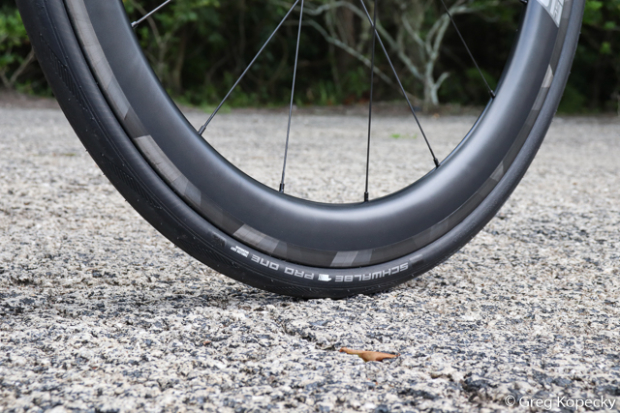
However, in the process of researching how to determine optimal tire pressure, it quickly apparent that we’d need to set the stage first, with a somewhat lengthy preamble about tire rolling resistance. Discussion about tire rolling resistance seems to grow by the day, and unfortunately it’s filled with confusion, misused terms, and some downright incorrect information. This article will explore rolling resistance at a bird’s eye view, to give you a basic understanding of what it is and how it impacts your speed.
A tire’s Coefficient of Rolling Resistance (Crr) refers to the power cost of the tire (and inner tube, if used). This is typically measured on a smooth metal drum or roller, and tells us how much energy it takes for the tire to deform and return to shape on the roller as it spins, which generates heat. Higher pressure results in lower rolling resistance and lower temperatures, because the tire deforms less.
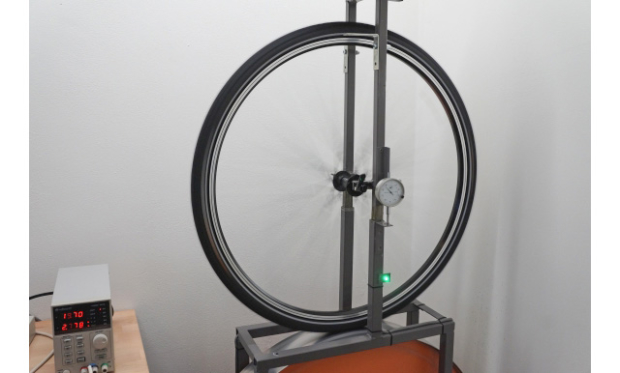
Above image © BicycleRollingResistance.com
In general, the tires that measure low in Crr are thin and flexible – often called "racing" tires. Also, larger tires tend to roll a bit faster, too (though we have to balance this with the aerodynamic cost). The best way to visualize it is this: Picture two 28mm-wide tires mounted to identical rims, and inflated to 50psi. One is an ultra thin cotton race tire, while the other is a burly commuting tire. Which one do you think will be easier to deform by pressing it with your thumb? The racing tire, of course. Now think of the road as your thumb, and repeat the process at 25mph for an hour… all of a sudden that extra resistance adds up.
As your tires roll, both the deformation from the road and subsequent return-to-shape of thicker tires 'cost' you more than fast tires – this great article by Tom Anhalt explains further detail.

The problem with Crr is that measurement on a smooth drum isn’t representative of the real surfaces on which we ride. We have cracks, bumps, rough pavement, and potholes – all slowing us down. We can simulate this using a textured drum for lab testing, but it still doesn’t give us the whole picture.
On a rigid bike without an active suspension system, your tires are doing the lion’s share of the suspension work. If you look at pavement at a highly magnified level, you’d see that even smooth-feeling pavement is far from perfect. Once the surfaces get rough enough and/or the tire pressure gets high enough, the tires can no longer absorb all of the vibration, which gets transferred into the bike and rider.
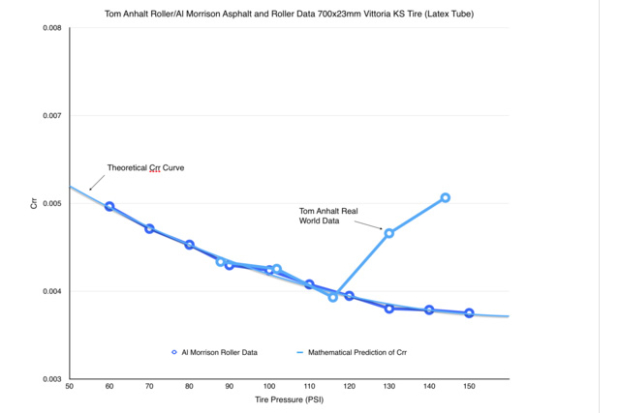
Above image © Silca
The graph above was borrowed from the Silca website , which has a great blog that goes into a deeper level of geekdom on this topic. For the non math nerds, a lower number is better, meaning that it requires less of your muscle input to power the bicycle.
Using roller data from Al Morrison and on-road data from Tom Anhalt, you can see a clear breakpoint in the graph where rolling resistance appears to increase sharply (around 115psi – and note that this was a relatively smooth road). Rougher roads result in a breakpoint at significantly lower pressures.
Silca calls these losses beyond the tires’ ability “impedance losses”. While it shows up on the Crr graph as more resistance (i.e. requiring more power from the rider to maintain speed) – the cause is not the tires themselves – but the energy that is lost as your bike and body get tossed and shaken around.
The graph below shows how much worse things get with rough pavement (the red line) – with the fastest setup at a low 60psi.
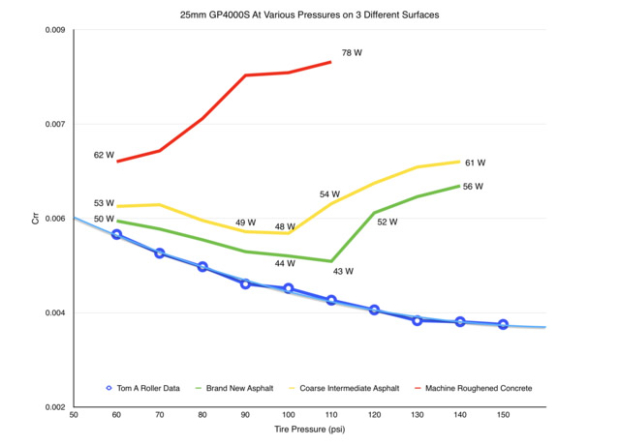
Above image © Silca
Silca goes on to suggest a more complete picture than pure Crr, called Total Rolling Loss (a combination of tire rolling resistance and impedance losses). HED coined a term for this years ago called Rolling Speed, while ENVE representatives called it “rolling efficiency” in a recent e-mail to us. The take-home is that – if you want to be accurate – you can’t say that “low tire pressure makes you go faster because it reduces rolling resistance." That’s an incorrect statement that I’ve probably made myself. High pressure actually reduces rolling resistance, but increases the chance of a heavy impedance cost. Tom Anhalt put it best in a recent e-mail, "On rigid bikes the idea is to be able to run low enough pressures so that the tires can be the majority of the suspension for the given conditions.” If you're running 120psi or more, you're almost certainly losing on the balance sheet.
The rub is that a higher pressure often “feels” faster. You feel every bit of road – the wheels might seem stiffer and faster – it’s as though every bit of your pedaling energy translates directly into forward motion, but this is a false intuition. In auto racing, the fastest setup doesn’t always feel the fastest to the driver. Drama feels fast. Skidding on the edge of the car’s limits feels fast. Staying planted, smooth, and drama-free doesn’t always feel so fast. This is an area that power meters have helped us greatly in breaking our false perceptions about what’s actually fast, giving us objective information to help guide our decisions.
Stay tuned for our next article, which will piggyback on the information presented here, to give a nuts-and-bolts recommendation of how to decide on your tire pressure.


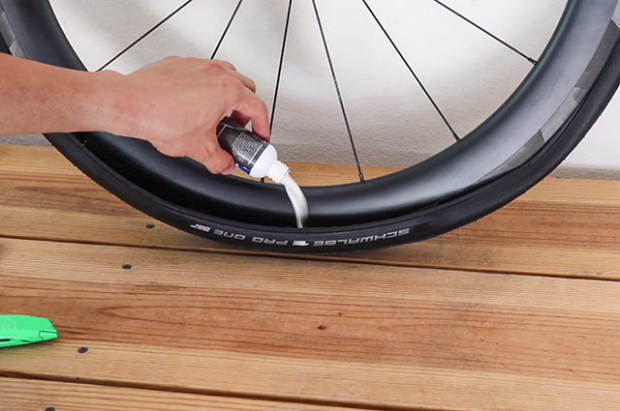
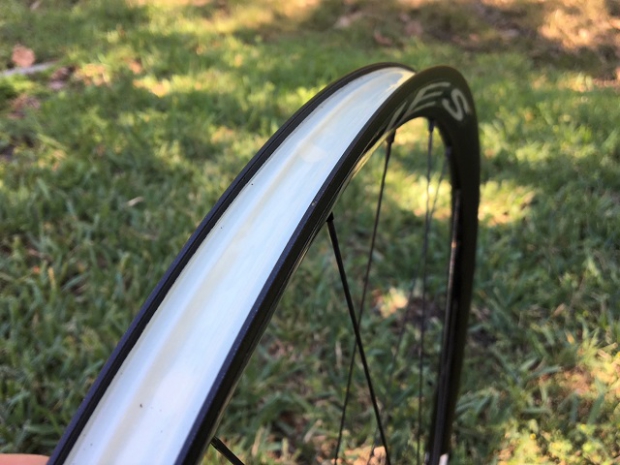
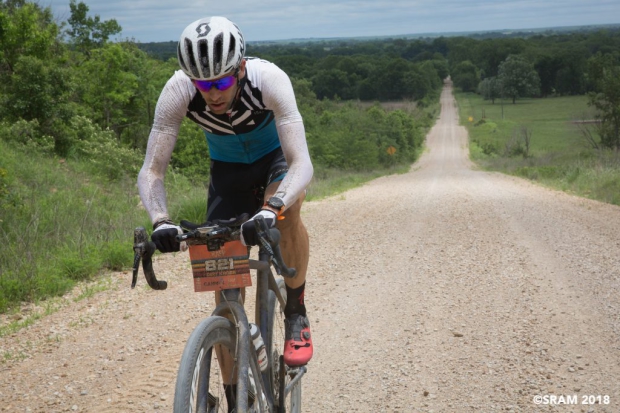
Start the discussion at slowtwitch.northend.network